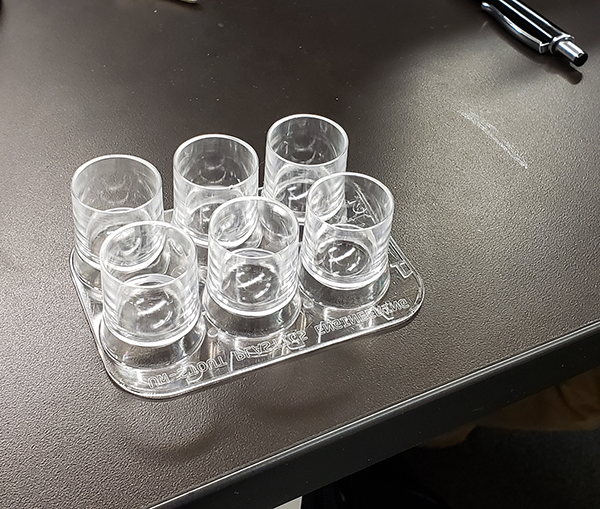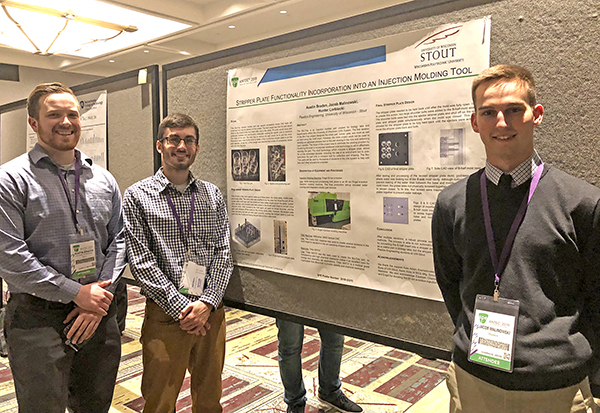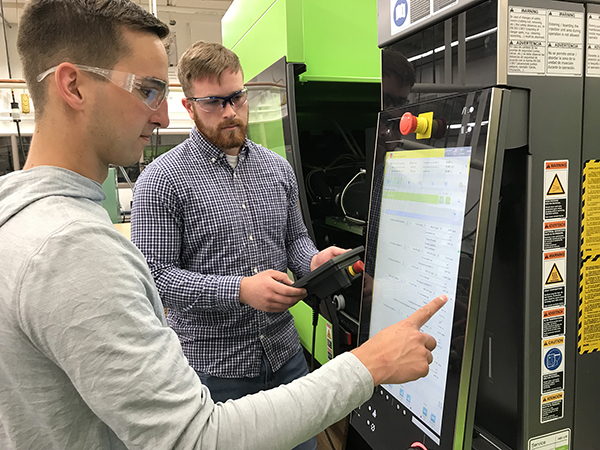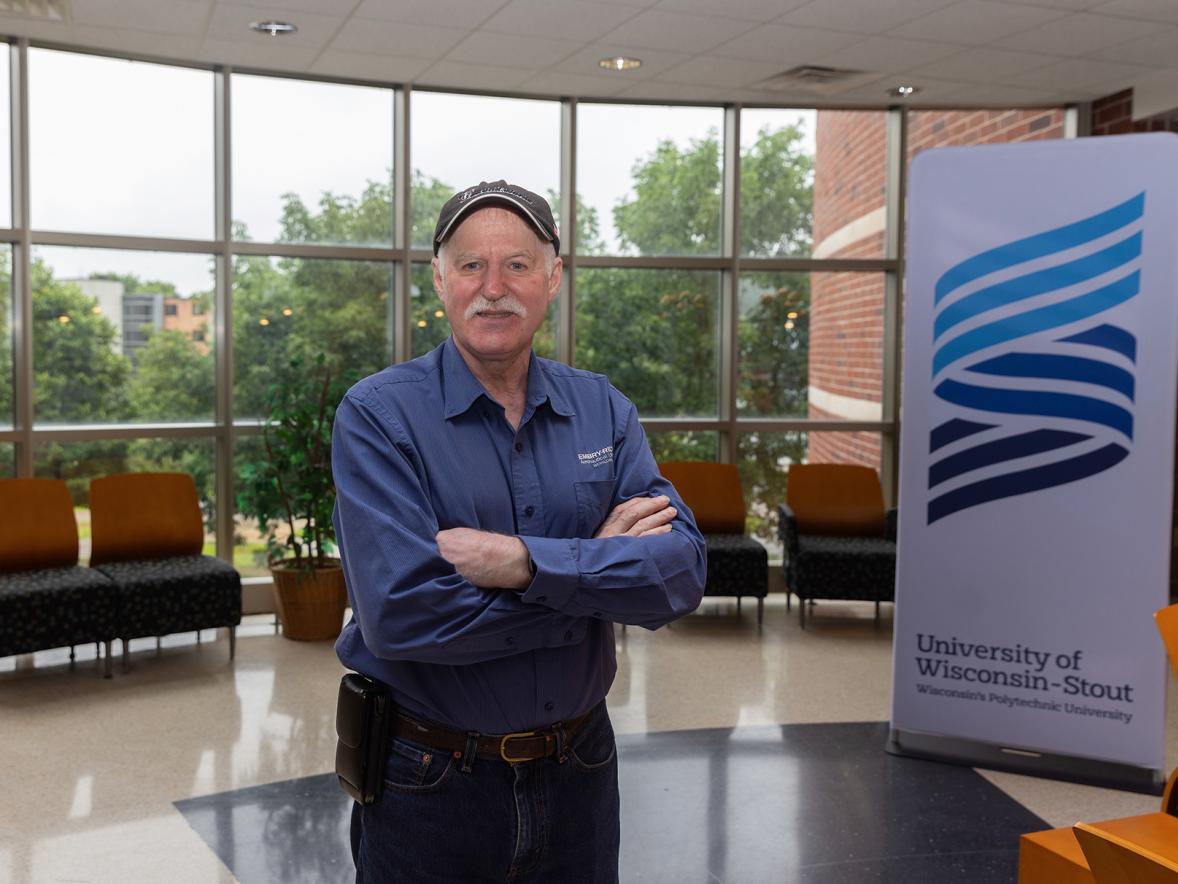Three University of Wisconsin-Stout plastics engineering students were proud when they presented their successful research project this spring to industry professionals in Detroit.
The Society of Plastics Engineers Annual Technical Conference — ANTEC — was a chance for them to network and talk about the details of what they had been working on since last fall.
So, it was a bonus when their research on a product called the Bio-Tray — designed to make lab testing easier — was entered in a competition against 44 other student projects and took second place. The Society of Plastics Engineers recognized the top five projects in the U.S.
 “It really hit me when we took second place. We weren’t expecting that,” said Jacob Malinowski, of Bloomer, one of the three senior team members.
“It really hit me when we took second place. We weren’t expecting that,” said Jacob Malinowski, of Bloomer, one of the three senior team members.
The team’s success didn’t surprise Adam Kramschuster, plastics engineering professor.
“It was a well-rounded project incorporating 3D design, hands-on manufacturing and programming/processing on injection molding equipment,” Kramschuster said.
The research also likely stood out because the students solved a problem that went back seven years at UW-Stout.
Bio-Tray is a clear plastic device, 3 inches by 4¼ inches, with six molded vials for holding lab testing materials. The original iteration was created by students in 2012 after professors wanted something more effective than what they were using — tubes stuck into foam blocks.
However, the new trays were never produced in high volume because they would stick to the mold in the injection machine, making production a problem. After sticking, the trays also would be punctured by the ejector pins.
 Along with Malinowski, team members Austin Braden, of Shoreview, Minn.; and Hunter Lorbiecki, of Menasha, took on the project for their 2018-19 senior capstone class. About eight months, 17 experiments and hundreds of hours later, they had a solution — a stripper plate.
Along with Malinowski, team members Austin Braden, of Shoreview, Minn.; and Hunter Lorbiecki, of Menasha, took on the project for their 2018-19 senior capstone class. About eight months, 17 experiments and hundreds of hours later, they had a solution — a stripper plate.
Essentially, they added a part to the steel mold created by students seven years ago. The stripper plate, with springs, pushes the Bio-Tray off the mold. To improve the process and product, they also designed a thicker base for the tray.
Engineering multiple solutions
The process of designing, machining and testing the stripper plate wasn’t easy, however. They ran into various problems after adding the plate to the mold inside the injection machine.
For example, water is injected into the mold to cool the 520-degree plastic, but with the new plate water began leaking. They eventually added four screws to clamp the mold to the plate.
Also, the new plate interfered with the water lines. They machined a pocket into the mold to reposition the water lines.
 After the research and development phase, they had to conduct scientific tests. For example, a molding test involved determining the correct melt temperature, plastic injection speed, amount of hold pressure once the mold is filled, amount of hold time and cooling time — all programmable.
After the research and development phase, they had to conduct scientific tests. For example, a molding test involved determining the correct melt temperature, plastic injection speed, amount of hold pressure once the mold is filled, amount of hold time and cooling time — all programmable.
“There were a lot of small victories, one at a time,” Malinowski said.
All those victories added up to a workable solution. Bio-Tray can be molded, removed by a robot and placed on a conveyor belt — a separate software programming solution — every 23 seconds, or more than 150 an hour.
The previous cycle time for a tray was about 45 seconds — if it didn’t stick to the mold.
“It was our project and for us to figure out, and it showed employers we have the ability to problem-solve,” Braden said. “It was a real-world application of engineering.”
Skills the team used while completing their project included computer-aided design, computer numerical control machining, injection molding and robot programming.
All three students graduated in May with a Bachelor of Science in plastics engineering. Malinowski is interning at Phillips-Medisize and will begin working there full time in June, rotating at first between the Eau Claire, Menomonie and Hudson facilities. Braden is considering several job offers. Lorbiecki will be a manufacturing engineer with MGS Manufacturing Group in Germantown.
Chuck Bomar, dean of the College of Science, Technology, Engineering, Mathematics and Management, said hundreds of Bio-Trays are being used in UW-Stout science labs. With the students’ research, the trays will be easier to reproduce for future students and could even be used beyond the university.
The Engel injection molding machine used by the students to solve the Bio-Tray problem was one of three donated over the past three years to UW-Stout’s plastics engineering lab.
###
Photos
A plastic lab tray designed at UW-Stout in 2012 can be reproduced more efficiently after research by three plastics engineering students.
From left, Austin Braden, Hunter Lorbiecki and Jacob Malinowski present their Bio-Tray research project, which took second in the nation at a Society of Plastics Engineers conference in Detroit.
Jacob Malinowski, left, and Austin Braden program the injection molding machine.





